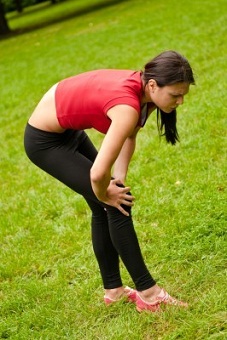
Runner's knee (Patellofemoral Pain Syndrome)
What is Runner's knee (Patellofemoral Pain Syndrome)?
Runner's knee is also known as patellofemoral pain
and is pain behind the kneecap. It has been given many names,
including patellofemoral disorder, patellar malalignment, runner's knee,
and chondromalacia.
How does Runners Knee (Patellofemoral Pain) occur?
Patellofemora pain is common among the runners.
Runners Knee occur due to overuse of the knee in sports such as cricket,
football, race, hockey, basketball and other activities such as
running, walking, jumping, or bicycling.
The kneecap (patella) is attached to the large group of muscles in
the thigh called the quadriceps. It is also attached to the shin bone by
the patellar tendon. The kneecap fits into grooves in the end of the
thigh bone (femur) called the femoral condyle. By repeated bending and
straightening of the knee, you may irritate the inside surface of the
kneecap and cause pain or it may completely rupture the ligament.
Runner's Knee also may result from the way your hips, legs, knees,
or feet are aligned. This alignment problem can be caused by your having
wide hips or underdeveloped thigh muscles, being knock-kneed, or having
feet with arches that collapse when walking or running (a condition
called over-pronation).
Symptoms of Runners Knee (Patellofemoral Pain):
- Severe pain behind the kneecap.
- Pain while you are walking or running or if you sit at a place for a long time.
- The pain generally becomes worse while you are walking downhill or down stairs. Your knee may swell at times.
- You may feel or hear snapping, popping, or grinding in the knee.
Treatment of Runners Knee (Patellofemoral Pain):
- Rest the knee and if there is swelling then apply R.I.C.E. treatment.(Rest , Ice , Compression , Elevation )
- Elevate your knee by placing a pillow underneath your leg while you are sitting.
- Anti-inflammatory medication may help reduce inflammation and pain.
- See a sports injury specialist who can advise on treatment and
provide a full rehabilitation program including self massage techniques.
- Take a glucosamine sulphate supplement. Glucosaimne Sulphate along
with Chondroitin has been shown to aid in the healing joint injuries.
When can I return to my sport or activity?
The goal of any rehabilitation program is to return you to your sport
or activity as soon and as safely as possible. But, if you return too
soon you may worsen your injury, which could lead to permanent damage.
Everyone recovers from injury at a different rate. Returning to your
sport or activity will be determined by your recovering ability, the
sooner your knee recovers, the sooner you will be able to return to your
sport or activity. Returning to your sport or activity is not
determined by how many days or weeks have passed since your injury
occurred. In general, the longer you have symptoms of the injury, the
longer it will take you to get better.
You may safely return to your sport or activity when, each of the following is true:
- Your injured knee can be fully straightened and bent without any pain.
- Your knee and leg have regained normal strength as it was there before the injury.
- You are able to jog straight ahead without any pain or limping.
- You are able to sprint straight ahead without any pain or limping.
- You are able to jump on your both legs without any pain.
Prevention of Runners Knee (Patellofemoral Pain):
Patellofemoral pain syndrome can best be prevented by
strengthening your thigh muscles, particularly the inside part of this
muscle group. It is also important to wear shoes that fit well and that
have good arch supports. Runners knee is also prevented by doing proper
warm ups such as running, sit ups or with the help of any of the popular
fitness equipments such as treadmill, steppers, dumbbells, home gyms, exercise bikes, strength trainers, etc ..before starting any sport.
A Sports Injury Professional or Doctor could:
- Prescribe anti-inflammatory medication e.g. ibuprofen.
Anti-inflammatory medication helps to reduce inflammation, especially in
the early stages of injury.
- Use ultrasound or laser treatment.
- Give a massage.
- Prescribe a full rehabilitation program.
- Advise on a gradual return to fitness.
| 

